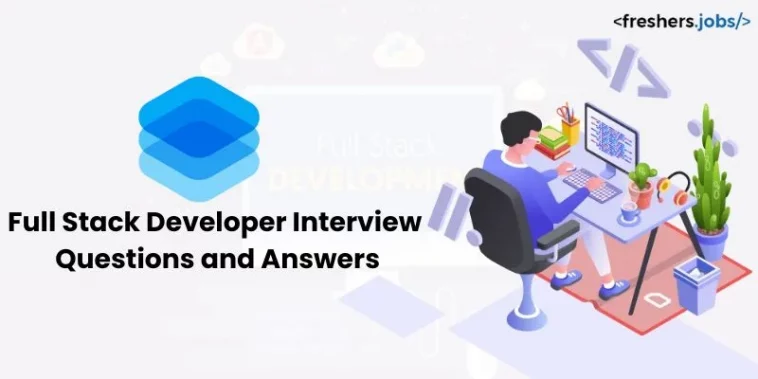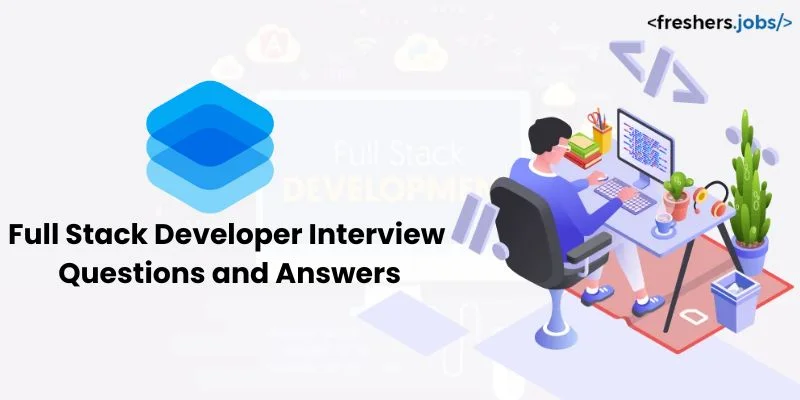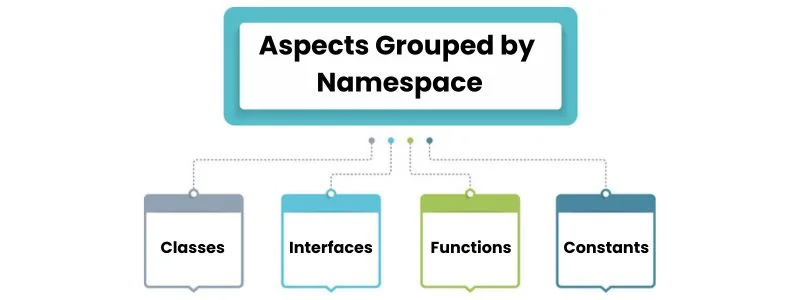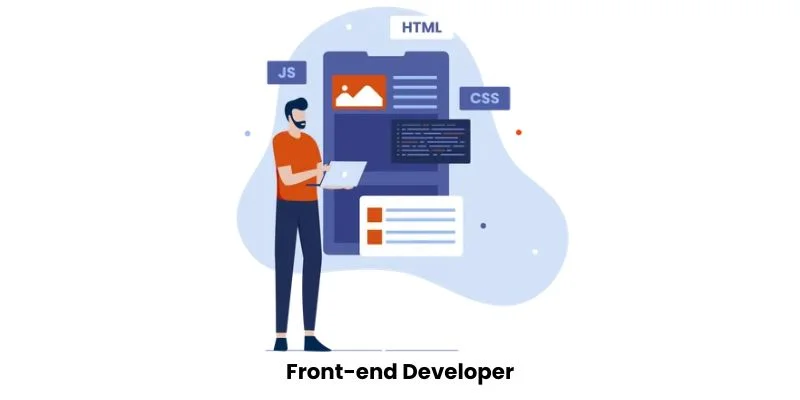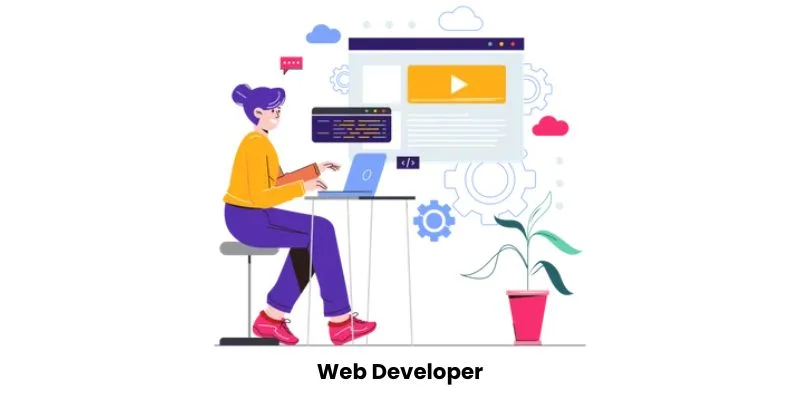Full-stack Development is simply a method of working with aspects of both Front-end & Back-end. A Full-stack developer would have knowledge in various layers of technology involved in covering the entire cycle of software development, right from user interface design to server and database management.
Front-end development occurs on the client side and is the designing and implementation of the user interface, which is empowered to make use of visual elements selectively across websites or applications. It is characterized by the use of technologies like HTML for structure, CSS for styling, and JavaScript for interactivity. Also used are frameworks and libraries such as React.js, Angular.js, and Vue.js, which extend functionality and further simplify development.
On the other hand, Back-end development refers to all activities on the server side, like processing data storage, security, and business logic. It ensures that the application performs well even when it is not visible to the clients. Major elements of Back-end development are servers covering client requests with the help of languages like Node.js, Python, Ruby, Java, and PHP, and databases like MySQL, PostgreSQL, MongoDB, and SQLite for data storage and retrieval. APIs, especially RESTful and GraphQL, enable software in communication. In frameworks, it involves Express, Django, Rails, and Spring, which are some really important tools in building robust and efficient Back-end systems. Freshers Jobs guides you with top 50 Full Stack Developer Interview Questions along with the Answers to help you handle your interview with confidence.
Full Stack Developer Interview Questions
We will explore Java, Python, and PHP-Based Full Stack Interview Questions to help you comprehend much more about the Full Stack field.
Full Stack Interview Questions
- Define Full Stack development.
Full Stack involves Front-end development that includes designing & coding of the user interface in a Web-based application as well as the Back-end development of the application and the actual database of the same application.
- List the primary aspects of Front-end development.
Some important components of Front-end development are:
- HTML
- CSS
- JavaScript
- List some popular Front-end frameworks and libraries.
Some of the commonly used Front-end frames and libraries are:
- Angular.js
- React.js
- Vue.js
- Explain what HTML is used for.
HTML is the basis of the web and focuses on appearance/presentation of the content and adding meaning to the structure of the document to be viewed in a browser.
- State the role of Cascading Style Sheets (CSS).
The essential role of CSS is to determine the styling and layout of web pages, enhancing their visual presentation, usability, and accessibility. CSS enables consistent style utility throughout all internet site pages, simplifying the procedure for developers to maintain and update their designs.
- State how JavaScript improves web pages.
JavaScript enables developers to feature interactive factors to web pages, such as drop-down menus, sliders, and pop-ups, improving user engagement and experience. It also allows web pages to show and update content dynamically without page refresh.
- Describe the purpose of a Back-end server.
A Back-end server handles the client and serves the data needed for it and the files necessary for the client’s action.
- List some popular server-side programming languages.
There are various server-side programming languages used. They are:
- Node
- JavaScript
- Python
- Ruby
- Java
- PHP
- Define the database and explain why it is important.
A database consists of a system or a program that maintains data and can also deliver that data, and it comes in handy when one wants to organize data managed by the application.
- Name some popular databases used in web development.
The most commonly used databases in web development are:
- MySQL
- PostgreSQL
- MongoDB
- SQLite
Intermediate Full Stack Development Interview Questions:
- Define Continuous integration.
CI or Continuous Integration which is a software program development method in which an individual or a team integrates code right into a shared supply time and again, and regularly detects in case of any integration errors as early as possible.
- Explain the role played by Testing in Full-stack development.
Testing is one of the development activities that are important in making sure that the applications are operating correctly and to rectify the error or bugs which might be found in it earlier than it is going to the real-time usage.
- What are unit tests?
Unit tests verify that each component within a software application is integrated correctly to perform their intended roles.
- Define a deployment in internet improvement.
Deployment is the approach of creating an internet application available to be used through moving it from a nearby development environment to a production server.
- State the difference between HTTP & HTTPS.
| HTTP | HTTPS |
| HTTP is the usual protocol for moving web pages. | HTTPS is defined as the secure version of HTTP, which utilizes SSL/TLS for data encryption. |
- Define a web server.
A web server is referred to as a hardware/software that serves web pages to customers in response to their requests, mostly through an internet browser.
- Define a CDN and explain why it is used.
A Content Delivery Network distributes web content across several servers in diverse locations to mitigate latency and enhance load times.
- What is responsive web design?
Responsive web design ensures net pages render properly on numerous gadgets and screen sizes using flexible layouts & media queries.
- What is AJAX?
Asynchronous JavaScript and XML permits internet pages to update asynchronously with the help of exchanging facts with an internet server in the background.
- What are web sockets?
Web sockets offer a complete-duplex communication channel over a single, lengthy-lived connection, enabling data exchange between customer and server.
Java Full Stack Developer Interview Questions
- What is the Spring Framework?
The Spring Framework is an extensive framework for constructing Java-based agency applications, supplying functions like dependency injection, transaction management, and web MVC.
- What is Spring Boot?
Spring Boot is known as an extension of the Spring Framework that makes the setup and development of new Spring packages easier by offering default configurations and embedded servers.
- What is Hibernate?
Hibernate is an Object-Relational Mapping or ORM framework for Java, which makes database interactions easier by mapping Java devices to database tables.
- Define Java Servlet API.
The Java Servlet API presents classes and interfaces for building web programs in Java, allowing developers to address HTTP requests and responses.
- What is JPA?
JPA (Java Persistence API) is a specification for coping with relational statistics in Java programs, imparting an API for item-relational mapping and information endurance.
Intermediate Interview Questions for Full Stack Java Developer:
- What is Maven?
Maven is a build automation device used broadly for Java projects, handling project dependencies, constructing strategies, and project documentation.
- What is Gradle?
Gradle is a build automation device that helps numerous languages and builds, providing flexibility and typical performance for huge-scale Java projects.
- State the difference between JDK, JRE, and JVM.
| JDK | JRE | JVM |
| JDK or Java Development Kit is a kit that helps in software program development for developing software applications in Java. | JRE (Java Runtime Environment) offers the libraries. | JVM (Java Virtual Machine) required to run Java programs, and JVM executes Java bytecode. |
- Define Spring Data JPA.
Spring Data JPA simplifies data access layers easier by means of providing repository support and eliminating boilerplate code for CRUD operations.
- What is the importance of @SpringBootApplication?
@SpringBootApplication is a convenience annotation that mixes @Configuration, @EnableAutoConfiguration, and @ComponentScan, permitting automated configuration and factor scanning in Spring Boot.
Python-Based Full Stack Developer Interview Questions
- What is a RESTful web provider?
A RESTful net service that employs HTTP methods to carry out CRUD operations and exchange data in a stateless way, normally the use of JSON or XML codecs.
- What is an ORM, and why is it beneficial?
Object-Relational Mapping is a manner that lets developers engage with a database by the usage of objects of their programming language, making database manipulation extra intuitive and lots less errors-inclined.
- What is SQLAlchemy?
SQLAlchemy is a famous ORM for Python that offers a full suite of famous enterprise-level persistence patterns designed for efficient database access.
- What is the position of __init__.Py in a Python package?
The __init__.Py document shows that the listing should be handled as a package, enabling it to be imported and applied in other Python scripts.
- What is the difference between a Module and a Package in Python?
| Module | Package |
| A Module is a single Python report with definitions and statements. | A Package is a set of modules in directories that offer a hierarchy. |
Intermediate Python-Based Full Stack Development Interview Questions:
- What is the difference between synchronous & asynchronous programming in Python?
| Synchronous programming | Asynchronous programming |
| Synchronous programming executes tasks sequentially, blocking off further execution till an assignment is complete. | Asynchronous programming allows tasks to run concurrently, improving efficiency and responsiveness. |
- What is FastAPI?
FastAPI is a present-day, rapid (high-overall performance) web framework for building APIs with Python 3.7+ depending on standard Python type pointers, acknowledged for its speed and simplicity of use.
- What is the position of the migrations folder in a Django assignment?
The migrations folder consists of migration files that report modifications to the database schema, taking into consideration easy model manipulation and schema updates.
- How does Django handle static files?
Django handles static files through the STATIC_URL and STATICFILES_DIRS settings, serving static files during development and collecting them for production with the collectstatic command.
- Explain the use of context processors in Django.
Context processors in Django are functions that return a dictionary of variables to be added to the context of every template, providing global context variables across the application.
PHP-Based Full Stack Interview Questions
- Define LAMP stack.
The LAMP stack is described as a collection of open-supply software utilized for internet enhancement, which includes Linux (OS), Apache, MySQL (database), and PHP.
- Define MVC structure.
MVC or Model-View-Controller is referred to as a design pattern that divides an utility into three interconnected additives: Model or data, View or UI, and Controller or business logic.
- What is a PHP session?
A PHP consultation is a method of storing data (in variables) for use throughout numerous pages. Session variables hold data approximately about one single user and are available to all pages in a single application.
- State the difference between include & require in PHP.
| require | include |
| require will produce a deadly error and forestall the script if the file can not be covered. | include will simplest produce a warning and the script will retain. |
- What is Composer?
Composer is a dependency supervisor for PHP, which allows developers to handle and install libraries and dependencies for their tasks.
Intermediate PHP-Based Full Stack Interview Questions:
- State the difference between GET & POST methods in HTTP?
| GET | POST |
| GET retrieves records from the server, commonly through a URL question string. | POST sends records to the server, often through shape submission, and is extra steady for sensitive statistics. |
- What is PDO in PHP?
PDO (PHP Data Objects) is a database access layer presenting a uniform method of entry to several databases, with organized statements and error handling.
- What is the motive of index. Hypertext Preprocessor record in a PHP utility?
The index.Php file is often the access point of a PHP application, handling all incoming requests and routing them to the right controllers or dealing with logic.
- What is a PHP namespace?
Namespaces in PHP are used to keep away from naming conflicts with the aid of grouping classes, interfaces, functions, and constants under a completely unique name.
- What is PHPUnit?
PHPUnit is referred to as a PHP testing framework, which allows developers to either write or run tests against their code to confirm whether it does, or does not behave as expected.
Career Prospects in Full Stack Development
Technology is rapidly developing, and nothing can stop it. Due to these advanced innovations around the digital world, companies have more need towards building software applications to satisfy the changing demands of their clients. As a result, there is a growing need for professionals with the Full Stack Developers skill set in the field and across organizations. It is becoming increasingly popular to outsource Full Stack Developers depending on the nature of the application so that start-up companies can build their own applications as well as customer’s applications.
Full Stack Developers pretty much already can cover a broad range of startups and even mid-sized companies; nevertheless, the exact same technical competencies that they have are in demand in large multinational corporations (MNCs) too. These developers possess diverse skills that aid companies in expanding their operations in various ways.
Full Stack Developers generally command higher salaries compared to other developers in the marketplace and enjoy superior career growth and stability. They also have the opportunity to switch to freelance developer status, either independently or concurrently, because an individual can single-handedly build an application from scratch, which will increase their earning potential.
As per certain reports, a Full Stack developer may earn between Rs 3,75,000 to Rs 5,45,000 in the initial years of the profession. Employees with 4 years experience are paid between Rs 5,53,006 & Rs 7,75,000. Full Stack Developers with 5-9 years of experience can earn an average salary from Rs 8,20,000 to Rs 13,75,689 per annum. Specifically, these salary packages depend on the particular skills that one possesses, years of experience, and the company that they join. Let’s discuss the job opportunities provided in the Full Stack Development field.
Entry-Level Full Stack Developer
Generally, the Entry-Level Full Stack Developer job is for fresh graduates or individuals with little working experience to be trained on the fundamentals of web development to work on both the Front-end and Back-end parts while closely being mentored by senior developers. They leverage the technologies more as tools to solve problems, they learn how to detect mistakes in developing code, and they contribute to small projects. Freshers for this job get an average salary ranging between Rs 3,75,000 & Rs 5,45,000 per year. Prominent companies like Deloitte, Capgemini, etc are hiring Front-end Developers.
Front-end Developer
Front-end Developers work on the application’s Front-end and are responsible for creating an attractive and smooth interface that customers can interact with. They can also design using technologies such as HTML, CSS, JavaScript, React.js, Angular.js and vue. js. Freshers can initially get an income ranging between Rs 3,50,000 to Rs 5,00,000 per year for this position. This role is centered on getting effective interfaces that are interactive and easy to use to capture the user.
Back-end Developer
Back-end Developers work in the server-side development, managing, collaborating, and developing the application’s database, server, and application logic. They use languages like PHP, python, ruby, java, node or any other required languages and databases like Mysql, PostgreSQL, MongoDB or any other databases which are required for a particular project. People who get selected in this position can easily draw anything between Rs 3,75,000 and Rs 5,50,000 per year in the initial joining itself. Back-end developers make sure all these aspects: servers, databases and applications are well integrated.
Web Developer
Web Developers are responsible for designing & creating websites or specific web application interfaces, and for the overall coding and management of Front and Back-end. Besides, they are proficient in Web technologies and its practices. The initial income for a fresher on this position levels from Rs 3,50,000 to Rs 5,00,000 per year. Web developers are involved in developing website interface designs which might be user friendly and optimize with the desires of the customers or the project.
Junior Full Stack Developer
Junior Full Stack Developers have some kind of experience and can handle tasks that are more challenging. They are involved in the creation and management of web applications, coding, and generating solutions alongside their colleagues for improving features. The annual salary for freshers in this job role starts from Rs 4,00,000 to Rs 6,00,000. While junior developers work on Full Stack development projects, they begin to explore deeper into one or two areas and gain more information regarding the other sections. For more such job opportunities, explore Free Alert Job.
Full Stack Developer
The Full Stack Developers with 1-4 years of experience take up more considerable work responsibilities and get involved in small projects and get more heavily involved in aspects of client and server-side on the system. They are well versed with various languages and frameworks and inclusive of the income that varies between Rs 5,53,006 to Rs 7,75,000 per annum. It is effective to ensure developers improve on their technical skills and also gain more understanding on project management and applications architecture.
Senior Full Stack Developer
Senior Full Stack Developers are experienced professionals with 5-9 years of working experience and they are solely responsible for the overall project or the entire development team. These are involved in architecting, constructing, and supporting complex web applications integrated with presentation logic and application logic respectively. These professionals also teach the new developers and come up with suggestions when it comes to planning and making decisions concerning the organization. The older and skilled developers are paid even more, with Rs 8,20,000 to Rs 13,75,689 per annum being the average range. They have the potential of impacting organizational business outcomes and advancing technologies and key solutions. Looking for Full-Stack related jobs in Pune? Explore Fresher Jobs in Pune.
Full Stack Development Team Lead
Full Stack Development Team is composed of developers who work under the FML while reporting and following the FML’s instructions to achieve project objectives. Being industry recognized for extensive experience and knowledge of both Front-end and Back-end development, they guarantee successful implementation of development projects right from the conceptual stage to completion. This role entails formulation of the main strategies, coordinating the resources available to give technical direction. It is essential for team leads to know that compensation packages may be somewhat higher than those of senior developers, more specifically, the compensation depends on company size and location.
The need for Full Stack Developers is constantly raised as companies strive to stay competitive in an ever-evolving digital landscape. This multifaceted position requires a complete understanding of both Front-end and Back-end technologies and needs continuous gaining knowledge of and addition to new tools and techniques. Preparing for an interview in this realm may be difficult, however with the right questions and thorough expertise, freshers can optimistically enhance their abilities and understanding. The top 50 Full Stack Developer Interview Questions and answers we’ve mentioned in this blog are designed to provide a strong foundation for aspiring developers, assisting them to expect and express their responses effectively. Look for an appropriate Institute that aligns with your skillset in Top 10 Full Stack Training Institutes in Chennai.

